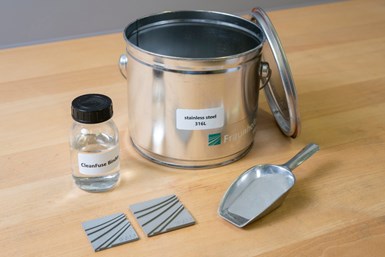ExOne, Fraunhofer IFAM Strengthen Partnership for Metal Binder, Materials Development
Fraunhofer IFAM and ExOne are working on a CleanFuse version for processing reactive materials such as aluminum and titanium.
CleanFuse Binder, stainless steel metal powder and 3D printed parts before (right) and after (left) sintering.
The ExOne Company, a provider of industrial sand and metal 3D printers using binder jetting technology, and the Fraunhofer Institute for Manufacturing Technology and Advanced Materials (Fraunhofer IFAM), an independent research institute in Europe, are strengthening their partnership for binder and materials development projects.
Fraunhofer IFAM and ExOne have decided to intensify their cooperation and are currently working on a CleanFuse metal binder version for processing reactive materials such as aluminum and titanium.
“At ExOne, we truly believe in the power of collaboration — of bringing together a diversity of experts and knowledge — to solve complex problems in the best possible way,” says Rick Lucas, ExOne chief technology officer and VP, new markets. “Fraunhofer IFAM has been a leading collaboration partner for us — helping to improve our understanding of binders, different types of powders and how they work together through the entire process chain from printing to final sintering to deliver a quality part.”
Fraunhofer IFAM’s relationship with ExOne on metal binder jetting development spans more than two decades. They have been working together since about 1998, when ExOne (then part of Extrude Hone) launched the RTS-300 commercial metal binder jetting system. In recent years, they have jointly refined and optimized CleanFuse, an ExOne binder based on a development by Fraunhofer IFAM. The result is a clean-burning binder for optimal 3D printing of stainless steels and premium metals, the company says.
Fraunhofer IFAM is said to have a strong foundation in the development and processing of metallic and polymer materials as well as comprehensive knowledge of additive manufacturing technologies — especially for sinter-based processes.
“When we started developing the first binder version on the Innovent, we soon realized we had a major breakthrough,” says Professor Frank Petzoldt, deputy director of Fraunhofer IFAM since 1999. “ExOne was immediately very enthusiastic about our development, because of its exceptional green part strength and clean burnout at low curing temperature. Together with ExOne, we refined the binder, which is now CleanFuse.”
Related Content
-
This Year I Have Seen a Lot of AM for the Military — What Is Going On?
Audience members have similar questions. What is the Department of Defense’s interest in making hardware via 3D printing over conventional methods? Here are three manufacturing concerns that are particular to the military.
-
AM 101: What Is Binder Jetting? (Includes Video)
Binder jetting requires no support structures, is accurate and repeatable, and is said to eliminate dimensional distortion problems common in some high-heat 3D technologies. Here is a look at how binder jetting works and its benefits for additive manufacturing.
-
How Norsk Titanium Is Scaling Up AM Production — and Employment — in New York State
New opportunities for part production via the company’s forging-like additive process are coming from the aerospace industry as well as a different sector, the semiconductor industry.














